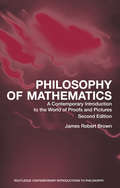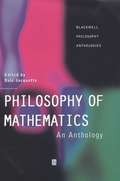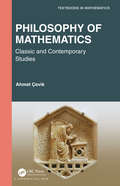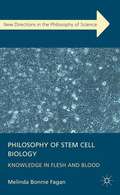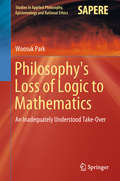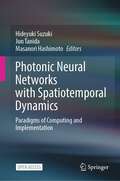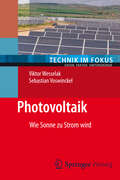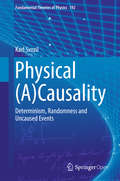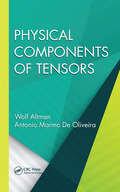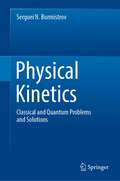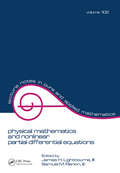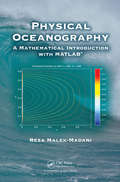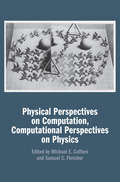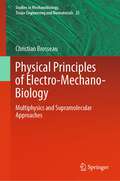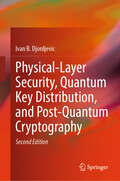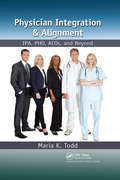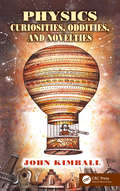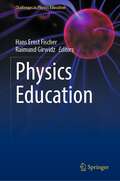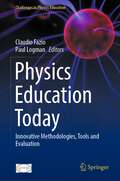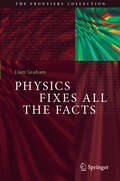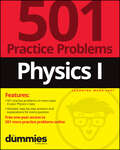- Table View
- List View
Philosophy of Mathematics: A Contemporary Introduction to the World of Proofs and Pictures (Routledge Contemporary Introductions to Philosophy)
by James Robert BrownIn his long-awaited new edition of Philosophy of Mathematics, James Robert Brown tackles important new as well as enduring questions in the mathematical sciences. Can pictures go beyond being merely suggestive and actually prove anything? Are mathematical results certain? Are experiments of any real value? This clear and engaging book takes a unique approach, encompassing non-standard topics such as the role of visual reasoning, the importance of notation, and the place of computers in mathematics, as well as traditional topics such as formalism, Platonism, and constructivism. The combination of topics and clarity of presentation make it suitable for beginners and experts alike. The revised and updated second edition of Philosophy of Mathematics contains more examples, suggestions for further reading, and expanded material on several topics including a novel approach to the continuum hypothesis.
Philosophy of Mathematics: An Anthology
by Dale JacquetteThis distinctive anthology explores the central problems and exposes intriguing new directions in the philosophy of mathematics.
Philosophy of Mathematics: Classic and Contemporary Studies (Textbooks in Mathematics)
by Ahmet CevikThe philosophy of mathematics is an exciting subject. Philosophy of Mathematics: Classic and Contemporary Studies explores the foundations of mathematical thought. The aim of this book is to encourage young mathematicians to think about the philosophical issues behind fundamental concepts and about different views on mathematical objects and mathematical knowledge. With this new approach, the author rekindles an interest in philosophical subjects surrounding the foundations of mathematics. He offers the mathematical motivations behind the topics under debate. He introduces various philosophical positions ranging from the classic views to more contemporary ones, including subjects which are more engaged with mathematical logic. Most books on philosophy of mathematics have little to no focus on the effects of philosophical views on mathematical practice, and no concern on giving crucial mathematical results and their philosophical relevance, consequences, reasons, etc. This book fills this gap. The book can be used as a textbook for a one-semester or even one-year course on philosophy of mathematics. "Other textbooks on the philosophy of mathematics are aimed at philosophers. This book is aimed at mathematicians. Since the author is a mathematician, it is a valuable addition to the literature." - Mark Balaguer, California State University, Los Angeles "There are not many such texts available for mathematics students. I applaud efforts to foster the dialogue between mathematics and philosophy." - Michele Friend, George Washington University and CNRS, Lille, France
Philosophy of Stem Cell Biology
by Melinda Bonnie FaganThis examination of stem cell biology from a philosophy of science perspective clarifies the field's central concept, the stem cell, as well as its aims, methods, models, explanations and evidential challenges. Relations to systems biology and clinical medicine are also discussed.
Philosophy of mathematics
by Hilary Putnam Paul BenacerrafThe twentieth century has witnessed an unprecedented 'crisis in the foundations of mathematics', featuring a world-famous paradox (Russell's Paradox), a challenge to 'classical' mathematics from a world-famous mathematician (the 'mathematical intuitionism' of Brouwer), a new foundational school (Hilbert's Formalism), and the profound incompleteness results of Kurt Gdel. In the same period, the cross-fertilization of mathematics and philosophy resulted in a new sort of 'mathematical philosophy', associated most notably (but in different ways) with Bertrand Russell, W. V. Quine, and Gdel himself, and which remains at the focus of Anglo-Saxon philosophical discussion. The present collection brings together in a convenient form the seminal articles in the philosophy of mathematics by these and other major thinkers. It is a substantially revised version of the edition first published in 1964 and includes a revised bibliography. The volume will be welcomed as a major work of reference at this level in the field.
Philosophy's Loss of Logic to Mathematics: An Inadequately Understood Take-Over (Studies in Applied Philosophy, Epistemology and Rational Ethics #43)
by Woosuk ParkThis book offers a historical explanation of important philosophical problems in logic and mathematics, which have been neglected by the official history of modern logic. It offers extensive information on Gottlob Frege’s logic, discussing which aspects of his logic can be considered truly innovative in its revolution against the Aristotelian logic. It presents the work of Hilbert and his associates and followers with the aim of understanding the revolutionary change in the axiomatic method. Moreover, it offers useful tools to understand Tarski’s and Gödel’s work, explaining why the problems they discussed are still unsolved. Finally, the book reports on some of the most influential positions in contemporary philosophy of mathematics, i.e., Maddy’s mathematical naturalism and Shapiro’s mathematical structuralism. Last but not least, the book introduces Biancani’s Aristotelian philosophy of mathematics as this is considered important to understand current philosophical issue in the applications of mathematics. One of the main purposes of the book is to stimulate readers to reconsider the Aristotelian position, which disappeared almost completely from the scene in logic and mathematics in the early twentieth century.
Phonon Thermal Transport in Silicon-Based Nanomaterials (SpringerBriefs in Physics)
by Rui-Qin Zhang Hai-Peng LiIn this Brief, authors introduce the advance in theoretical and experimental techniques for determining the thermal conductivity in nanomaterials, and focus on review of their recent theoretical studies on the thermal properties of silicon–based nanomaterials, such as zero–dimensional silicon nanoclusters, one–dimensional silicon nanowires, and graphenelike two–dimensional silicene. The specific subject matters covered include: size effect of thermal stability and phonon thermal transport in spherical silicon nanoclusters, surface effects of phonon thermal transport in silicon nanowires, and defects effects of phonon thermal transport in silicene. The results obtained are supplemented by numerical calculations, presented as tables and figures. The potential applications of these findings in nanoelectrics and thermoelectric energy conversion are also discussed. In this regard, this Brief represents an authoritative, systematic, and detailed description of the current status of phonon thermal transport in silicon–based nanomaterials. This Brief should be a highly valuable reference for young scientists and postgraduate students active in the fields of nanoscale thermal transport and silicon-based nanomaterials.
Photonic Neural Networks with Spatiotemporal Dynamics: Paradigms of Computing and Implementation
by Hideyuki Suzuki Jun Tanida Masanori HashimotoThis open access book presents an overview of recent advances in photonic neural networks with spatiotemporal dynamics. The computing and implementation paradigms presented in this book are outcomes of interdisciplinary studies by collaborative researchers from the three fields of nonlinear mathematical science, information photonics, and integrated systems engineering. This book offers novel multidisciplinary viewpoints on photonic neural networks, illustrating recent advances in three types of computing methodologies: fluorescence energy transfer computing, spatial-photonic spin system, and photonic reservoir computing. The book consists of four parts: Part I introduces the backgrounds of optical computing and neural network dynamics; Part II presents fluorescence energy transfer computing, a novel computing technology based on nanoscale networks of fluorescent particles; Parts III and IV review the models and implementation of spatial-photonic spin systems and photonic reservoir computing, respectively. These contents are beneficial to researchers in a broad range of fields, including information science, mathematical science, applied physics, and engineering, to better understand the novel computing concepts of photonic neural networks with spatiotemporal dynamics.
Photovoltaik
by Viktor Wesselak Sebastian VoswinckelWie funktioniert Photovoltaik? Welche Arten von Solarzellen gibt es? Wie wirtschaftlich sind Photovoltaik-Anlagen? Die Autoren erklären die wichtigsten Eigenschaften der Sonnenstrahlung und vermitteln die prinzipielle Funktionsweise einer Solarzelle. Sie gehen auf die Unterschiede heutiger und zukünftiger Technologien ein und diskutieren die Wirtschaftlichkeit unterschiedlicher Anlagenkonzepte. Dadurch finden Leser einen schnellen Einstieg ins Thema und lernen unterschiedliche Technologien und Anlagenvarianten einzuordnen und zu beurteilen.
Physical (A)Causality
by Karl SvozilThis open access book addresses the physical phenomenon of events that seem to occur spontaneously and without any known cause. These are to be contrasted with events that happen in a (pre-)determined, predictable, lawful, and causal way. All our knowledge is based on self-reflexive theorizing, as well as on operational means of empirical perception. Some of the questions that arise are the following: are these limitations reflected by our models? Under what circumstances does chance kick in? Is chance in physics merely epistemic? In other words, do we simply not know enough, or use too crude levels of description for our predictions? Or are certain events "truly", that is, irreducibly, random? The book tries to answer some of these questions by introducing intrinsic, embedded observers and provable unknowns; that is, observables and procedures which are certified (relative to the assumptions) to be unknowable or undoable. A (somewhat iconoclastic) review of quantum mechanics is presented which is inspired by quantum logic. Postulated quantum (un-)knowables are reviewed. More exotic unknowns originate in the assumption of classical continua, and in finite automata and generalized urn models, which mimic complementarity and yet maintain value definiteness. Traditional conceptions of free will, miracles and dualistic interfaces are based on gaps in an otherwise deterministic universe.
Physical Components of Tensors (Applied and Computational Mechanics)
by Wolf Altman Antonio Marmo OliveiraIllustrating the important aspects of tensor calculus, and highlighting its most practical features, Physical Components of Tensors presents an authoritative and complete explanation of tensor calculus that is based on transformations of bases of vector spaces rather than on transformations of coordinates. Written with graduate students, professors, and researchers in the areas of elasticity and shell theories in mind, this text focuses on the physical and nonholonomic components of tensors and applies them to the theories. It establishes a theory of physical and anholonomic components of tensors and applies the theory of dimensional analysis to tensors and (anholonomic) connections. This theory shows the relationship and compatibility among several existing definitions of physical components of tensors when referred to nonorthogonal coordinates. The book assumes a basic knowledge of linear algebra and elementary calculus, but revisits these subjects and introduces the mathematical backgrounds for the theory in the first three chapters. In addition, all field equations are also given in physical components as well.Comprised of five chapters, this noteworthy text: Deals with the basic concepts of linear algebra, introducing the vector spaces and the further structures imposed on them by the notions of inner products, norms, and metrics Focuses on the main algebraic operations for vectors and tensors and also on the notions of duality, tensor products, and component representation of tensors Presents the classical tensor calculus that functions as the advanced prerequisite for the development of subsequent chapters Provides the theory of physical and anholonomic components of tensors by associating them to the spaces of linear transformations and of tensor products and advances two applications of this theory Physical Components of Tensors contains a comprehensive account of tensor calculus, and is an essential reference for graduate students or engineers concerned with solid and structural mechanics.
Physical Kinetics: Classical and Quantum Problems and Solutions
by Serguei N. BurmistrovThis book includes problems based on the material in the course of physical kinetics for the students of general and applied physics. It contains 60 problems with detailed solutions. The comments to the problems reflect the connection with the problems and methods of modern physical kinetics. A brief introduction gives the necessary information for solving and understanding the problems. The book is proposed for students and postgraduates studying the theoretical physics. The book is used as a supplement to the textbooks published on physical kinetics. The purpose of the book is to help students in training the practical skills and mastering the basic elements of physical kinetics. To understand the subject matter, it is sufficient to know the traditional courses of theoretical physics.
Physical Mathematics
by Kevin CahillUnique in its clarity, examples and range, Physical Mathematics explains as simply as possible the mathematics that graduate students and professional physicists need in their courses and research. The author illustrates the mathematics with numerous physical examples drawn from contemporary research. In addition to basic subjects such as linear algebra, Fourier analysis, complex variables, differential equations and Bessel functions, this textbook covers topics such as the singular-value decomposition, Lie algebras, the tensors and forms of general relativity, the central limit theorem and Kolmogorov test of statistics, the Monte Carlo methods of experimental and theoretical physics, the renormalization group of condensed-matter physics and the functional derivatives and Feynman path integrals of quantum field theory.
Physical Mathematics and Nonlinear Partial Differential Equations
by James H. LightbourneThis volume consists of the proceedings of the conference on Physical Mathematics and Nonlinear Partial Differential Equations held at West Virginia University in Morgantown. It describes some work dealing with weak limits of solutions to nonlinear systems of partial differential equations.
Physical Oceanography: A Mathematical Introduction with MATLAB (Advances in Applied Mathematics)
by Reza Malek-MadaniAccessible to advanced undergraduate students, Physical Oceanography: A Mathematical Introduction with MATLAB demonstrates how to use the basic tenets of multivariate calculus to derive the governing equations of fluid dynamics in a rotating frame. It also explains how to use linear algebra and partial differential equations (PDEs) to solve basic i
Physical Perspectives on Computation, Computational Perspectives on Physics
by Michael E. Cuffaro Samuel C. FletcherAlthough computation and the science of physical systems would appear to be unrelated, there are a number of ways in which computational and physical concepts can be brought together in ways that illuminate both. <P><P>This volume examines fundamental questions which connect scholars from both disciplines: is the universe a computer? Can a universal computing machine simulate every physical process? What is the source of the computational power of quantum computers? Are computational approaches to solving physical problems and paradoxes always fruitful? Contributors from multiple perspectives reflecting the diversity of thought regarding these interconnections address many of the most important developments and debates within this exciting area of research. Both a reference to the state of the art and a valuable and accessible entry to interdisciplinary work, the volume will interest researchers and students working in physics, computer science, and philosophy of science and mathematics.<P> Fills the gap in the book-length treatments of the interrelations between computation and physics, especially within philosophy.<P> Provides a reference point for the state of the art in important topics and research questions in this area.<P> Brings together scholars from a wide range of perspectives and disciplines.
Physical Principles of Electro-Mechano-Biology: Multiphysics and Supramolecular Approaches (Studies in Mechanobiology, Tissue Engineering and Biomaterials #25)
by Christian BrosseauThis book covers the recently developed understanding of Electro-Mechano-Biology (EMB) in which the focus is primarily on the couplings between the electric and mechanical fields. The emphasis lies on the analytical and computational aspects of EMB at the cellular level. The book is divided into two parts. In the first part, the author starts by defining and discussing the relevant basic aspects of the electrical and mechanical properties of cell membranes. He provides an overview of some of the ways analytical modelling of cell membrane electrodeformation (ED) and electroporation (EP) appears in a variety of contexts as well as a contemporary account of recent developments in computational approaches that can feature in the theory initiative, particularly in its attempt to describe the cohort of activities currently underway. Intended to serve as an introductory text and aiming to facilitate the understanding of the field to non-experts, this part does not dwell on the set of topics, such as cellular mechanosensing and mechanotransduction, irreversible EP, and atomistic molecular dynamics modelling of membrane EP. The second (and larger) part of the book is devoted to a presentation of the necessary analytical and computational tools to illustrate the ideas behind EMB and illuminate physical insights. Brief notes on the history of EMB and its many applications describing the variety of ideas and approaches are also included. In this part, the background of the first principles and practical calculation methods are discussed to highlight aspects that cannot be found in a single volume.
Physical-Layer Security, Quantum Key Distribution, and Post-Quantum Cryptography
by Ivan B. DjordjevicThis book introduces the reader to the most advanced topics of physical-layer security (PLS), cryptography, covert/stealth communications, and quantum key distribution (QKD), also known as the quantum cryptography, and post-quantum cryptography (PQC). So far, these topics have been considered as separate disciplines, even though they are targeting the same security problems we are facing today. The book integrates modern cryptography, physical-layer security, QKD, covert communication, PQC, and cyber security technologies. The book is intended for a very diverse group of readers in communications engineering, optical engineering, wireless communications, free-space optical communications, optical wireless communications, mathematics, physics, communication theory, information theory, photonics, as well as computer science.
Physician Integration & Alignment: IPA, PHO, ACOs, and Beyond
by Maria K. ToddToday, with physician and hospital reimbursement being cut and tied to quality incentives, physicians and health plans are revisiting the concept of integration. Payers are demanding that the industry do more with less without sacrificing quality of care. As a result, physicians again find themselves integrating and aligning with hospitals that hav
Physics Curiosities, Oddities, and Novelties
by John KimballAn Enlightening Way to Navigate through Mind-Boggling Physics ConceptsPhysics Curiosities, Oddities, and Novelties highlights unusual aspects of physics and gives a new twist to some fundamental concepts. The book covers both classical and modern physics in an engaging, straightforward style.The author presents perplexing questions that often lack
Physics Education (Challenges in Physics Education)
by Raimund Girwidz Hans Ernst FischerThis book offers a comprehensive overview of the theoretical background and practice of physics teaching and learning and assists in the integration of highly interesting topics into physics lessons. Researchers in the field, including experienced educators, discuss basic theories, the methods and some contents of physics teaching and learning, highlighting new and traditional perspectives on physics instruction. A major aim is to explain how physics can be taught and learned effectively and in a manner enjoyable for both the teacher and the student. Close attention is paid to aspects such as teacher competences and requirements, lesson structure, and the use of experiments in physics lessons. The roles of mathematical and physical modeling, multiple representations, instructional explanations, and digital media in physics teaching are all examined. Quantitative and qualitative research on science education in schools is discussed, as quality assessment of physics instruction. The book is of great value to researchers involved in the teaching and learning of physics, to those training physics teachers, and to pre-service and practising physics teachers.
Physics Education Today: Innovative Methodologies, Tools and Evaluation (Challenges in Physics Education)
by Claudio Fazio Paul LogmanThis book provides an in-depth exploration of the latest developments in physics education. It presents a comprehensive look into cutting-edge research and ideas used to improve physics education around the world. Topics covered include (but are not limited to) the use of problem-based learning, the design and evaluation of teaching materials, and the use of digital technologies. This book is essential for anyone looking to stay up-to-date on the latest educational innovations and to develop an understanding of effective teaching approaches. It is aimed at researchers, teachers, students, policymakers, and educational leaders in the field of physics education.
Physics Fixes All the Facts (The Frontiers Collection)
by Liam GrahamComplex systems seem to magically emerge from the interactions of their parts. A whirlpool emerges from water molecules. A living cell from organic molecules. You emerge from the cells of your body. Not since chaos has a concept from physics spread like wildfire to other disciplines. Emergence can be found from chemistry to economics; from psychology to ecology. At its heart is the alluring idea that there’s more to the world than physics, that there is a holistic component to nature, an edge of mystery. “Physics Fixes All the Facts” starts by taking you on a tour through a fascinating world of complexity, exploring phenomena from the inside of an atomic nucleus to bacterial behaviour to the ability of your thoughts to affect the world. These examples are used along with a thorough exploration of the philosophical literature to untangle the notoriously poorly defined concept of emergence. This reveals something surprising: the term emergence is redundant. In its weak form it is so weak that it applies to everything. In its strong form it is so restrictive that it is like the belief that there are pixies in your garden, impossible to exclude but not worth spending your time on. Emergence either applies to all systems or to none. Rather than telling us something about the nature of the world, it is an illusion, an artefact of our cognitive limitations. The past decade has seen a dozen or so monographs and collections about emergence, almost all resolutely supportive of the concept. This book aims to redress the balance. But it is more than just a campaign against the idea of emergence. Graham presents a framework called Austere Physicalism and argues that it is the only coherent way to view the world. He uses this framework to reinterpret so-called emergent phenomena and investigates its wider implications for science. In this radically materialist view, we are nothing but physical systems among others. “Physics Fixes All the Facts” ends by exploring what this means for our sense of free will and consciousness. The book will appeal to academics in fields which use the concepts of complexity or emergence. Scientists and philosophers alike will find unexpected and exciting ideas in these pages. But the target audience is much broader including students who want to add context to their studies and the intellectually curious with some scientific background.
Physics I For Dummies
by Steven HolznerAn easy-to-follow guide to introductory physics, from the Big Bang to relativity All science, technology, engineering, and math majors in college and university require some familiarity with physics. Other career paths, like medicine, are also only open to students who understand this fundamental science. But don’t worry if you find physics to be intimidating or confusing. You just need the right guide! In Physics I For Dummies, you’ll find a roadmap to physics success that walks you through every major topic in introductory physics, including motion, energy, waves, thermodynamics, electromagnetism, relativity, and more. You’ll learn the basic principles and math formulas of physics through clear and straightforward examples and instruction, and without unnecessary jargon or complicated theory. In this book, you’ll also find: Up-to-date examples and explanations appearing alongside the latest discoveries and research in physics, discussed at a level appropriate for beginning students All the info found in an intro physics course, arranged in an intuitive sequence that will give first-year students a head start in their high school or college physics class The latest teaching techniques to ensure that you remember and retain what you read and practice in the bookPhysics I For Dummies is proof that physics can fun, accessible, challenging, and rewarding, all at the same time! Whether you’re a high school or undergraduate student looking for a leg-up on basic physics concepts or you’re just interested in how our universe works, this book will help you understand the thermodynamic, electromagnetic, relativistic, and everything in between.
Physics I: 501 Practice Problems For Dummies (+ Free Online Practice)
by The Experts at DummiesOvercome your study inertia and polish your knowledge of physics Physics I: 501 Practice Problems For Dummies gives you 501 opportunities to practice solving problems from all the major topics covered you Physics I class—in the book and online! Get extra help with tricky subjects, solidify what you’ve already learned, and get in-depth walk-throughs for every problem with this useful book. These practice problems and detailed answer explanations will help you succeed in this tough-but-required class, no matter what your skill level. Thanks to Dummies, you have a resource to help you put key concepts into practice. Work through practice problems on all Physics I topics covered in school classes Step through detailed solutions to build your understanding Access practice questions online to study anywhere, any time Improve your grade and up your study game with practice, practice, practiceThe material presented in Physics I: 501 Practice Problems For Dummies is an excellent resource for students, as well as parents and tutors looking to help supplement Physics I instruction. Physics I: 501 Practice Problems For Dummies (9781119883715) was previously published as Physics I Practice Problems For Dummies (9781118853153). While this version features a new Dummies cover and design, the content is the same as the prior release and should not be considered a new or updated product.
